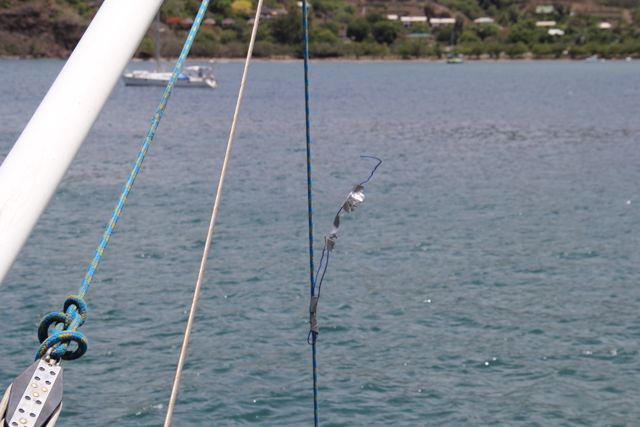We have a wifi internet connection, so we were able to review all the blog posts – thanks very much to our friends – we were definitely not alone out there.
To add some pictures and comments on the projects.
The solar project has been a great success. We are producing between 2.2 – 3.1 kwh per day – which is at the high end of our expectations. This will easily allow us to only need 1 hour of generator per day when at anchor.

Blower wiring project, we just post a picture of the 230v AC wiring – we had to sort our way through that maze to wire the port side blower to the inverter. We had a good instructor – Melt Emms from Raven Marine – available by email and sat phone when we need him.

Flopper stopper repair
Old version

New version

Another view – note the bird repellant at the end, which would be sticking up on top when flopper stopper is retracted.

Newly installed Bose speaker – and the 100ft sailboat that is our neighbor here in Nuku Hiva.

Trip Stats: Total distance: 2676 nautical miles, average speed: 7.5k, fuel burn: 3.5 gph, engine hours: 361, total fuel consumed: 1278 gallons, fuel remaining: 895.
Trip started from Isla San Benedicto, MX.

We saw this cargo ship (China – Peru) on Day 4, and she was the last ship we saw before landfall at Nuku Hiva.

Last sunset in the northern hemisphere.

Sunrise as we approach Nuku Hiva.

First sight of land after two weeks! Nuku Hiva, here we come.

We hooked a decent yellowfin tuna on the way in. Our biggest catch so far.

A very productive catch.

Dinner for weeks …

Just a few thoughts on the passage. We noted during the passage, we passed time by looking at the world cruising routes and contemplating some of the other places in the world to visit. The 2600 miles from North America to the Society Islands is one of the longest passages without landfall in the world. It would be an understatement to say we feel a sense of accomplishment to complete this passage with so little to worry about.
It’s a credit to Nordhavn’s voyaging under power philosophy in that two of us can take a 100 ton boat 2600 miles across one third of the Pacific Ocean. We were able to deal with the small mechanical issues, fix a few small things and arrive so rested we toured an extra 50 miles; caught and cleaned a 30lb tuna; anchored and didn’t even take a nap. I can honestly say the boat is as good if not better condition then when we left.
We truly feel we can go anywhere in the world we want, and look forward to many more adventures.
[google-map-v3 width=”350″ height=”350″ zoom=”7″ maptype=”satellite” mapalign=”center” directionhint=”false” language=”default” poweredby=”false” maptypecontrol=”true” pancontrol=”true” zoomcontrol=”true” scalecontrol=”true” streetviewcontrol=”true” scrollwheelcontrol=”false” draggable=”true” tiltfourtyfive=”false” addmarkermashupbubble=”false” addmarkermashupbubble=”false” addmarkerlist=”-8.9155,-140.10010{}cruiseship.png” bubbleautopan=”true” showbike=”false” showtraffic=”false” showpanoramio=”false”]